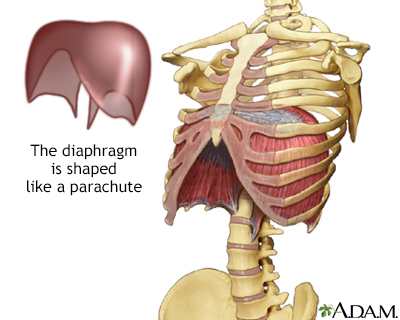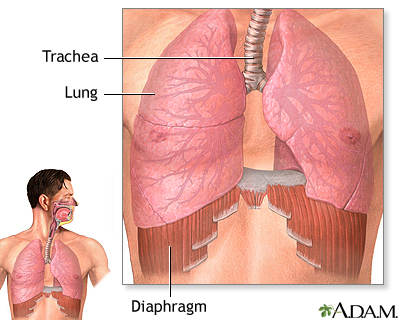Definition
A normal breathing rate for an adult at rest is 8 to 16 breaths per minute. For an infant, a normal rate is up to 44 breaths per minute.
Tachypnea is the term that your health care provider uses to describe your breathing if it is too fast, especially if you have fast, shallow breathing from a lung disease or other medical cause.
The term hyperventilation is usually used if you are taking rapid, deep breaths. This can be due to lung disease or because of anxiety or panic. The terms are sometimes used interchangeably.
Alternative Names
Tachypnea; Breathing - rapid and shallow; Fast shallow breathing; Respiratory rate - rapid and shallow
Causes
Shallow, rapid breathing has many possible medical causes, including:
- Asthma
- Blood clot in an artery in the lung
- Choking
- Chronic obstructive pulmonary disease (COPD) and other chronic lung diseases
- Heart failure
- Infection in the smallest air passages of the lungs in children (bronchiolitis)
- Pneumonia or other lung infection
- Transient tachypnea of the newborn
- Anxiety and panic
- Other serious lung disease, such as interstitial lung disease or bronchiectasis
Home Care
Rapid, shallow breathing should not be treated at home. It is generally considered a medical emergency (unless anxiety is the only cause).
If you have asthma or COPD, use your inhaler or nebulizer medicines as prescribed by your provider. You may still need to be checked by a provider right away if you have rapid shallow breathing. Your provider will explain when it is important to go to the emergency room.
When to Contact a Medical Professional
Call 911 or the local emergency number, or go to the emergency room if you are breathing rapidly and you have:
- Bluish or grayish color to the skin, nails, gums, lips, or the area around the eyes (cyanosis)
- Chest pain
- Chest that is pulling in with each breath
- Fever
- Labored or difficult breathing
- Never had rapid breathing before
- Symptoms that are getting more severe
What to Expect at Your Office Visit
The provider will do a thorough exam of your heart, lungs, abdomen, and head and neck.
Tests that may be ordered include:
Treatment will depend on the underlying cause of the rapid breathing. Treatment may include oxygen if your oxygen level is too low. If you are having an asthma or a COPD attack, you'll receive treatment to stop the attack.
Many times, this evaluation will need to be done in an emergency room setting.
References
Kraft M. Approach to the patient with respiratory disease. In: Goldman L, Schafer AI, eds. Goldman-Cecil Medicine. 26th ed. Philadelphia, PA: Elsevier; 2020:chap 77.
McGee S. Respiratory rate and abnormal breathing patterns. In: McGee S, ed. Evidence-Based Physical Diagnosis. 4th ed. Philadelphia, PA: Elsevier; 2018:chap 19.



